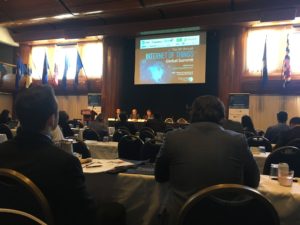I’ve been giving a lot of thought recently about how my vision of I0T-based “SmartAging” through a combination of:
- Quantified Self health apps and devices to improve seniors’ health and turn their health care into more of a partnership with their doctors
- and smart home devices that would make it easier to manage their homes and “age in place” rather than being institutionalized
could meld with the exciting developments in smart city devices and strategy. I believe the results could make seniors happier and healthier, reduce the burdens on city budgets of growing aging populations, and spur unprecedented creativity and innovation on these issues. Here’s my vision of how the two might come together. I’d welcome your thoughts on the concept!
A Vision for Dynamic and Lower-Cost Aging in Cities Through “SmartAging”
It’s clear business as usual in dealing with aging in America won’t work anymore. 10,000 baby boomers a day retire and draw Social Security. Between now and 2050, seniors will be the fastest growing segment of the population. How can we stretch government programs and private resources so seniors won’t be sickly and live in abject poverty, yet millennials won’t be bankrupted either?
As someone in that category, this is of more than passing interest to me!
I propose a new approach to aging in cities, marrying advanced but affordable personal technology, new ways of thinking about aging, and hybrid formal and ad hoc public-private partnerships, which can deal with at least part of the aging issue. Carving out some seniors from needing services through self-reliance and enhancing their well-being would allow focusing scarce resources on the most vulnerable remaining seniors.
The approach is made possible not only by the plummeting cost and increasing power of personal technology but also the exciting new forms of collaboration it has made possible.
The proposal’s basis is the Internet of Things (IoT). There is already a growing range of IoT wearable devices to track health indicators such as heart rates and promoting fitness activities, and IoT “smart home” devices controlling lighting, heat, and other systems. The framework visualized here would easily integrate these devices, but they can be expensive, so it is designed so seniors could benefit from the project without having to buy the dedicated devices.
This proposal does not attempt to be an all-encompassing solution to every issue of aging, but instead will create a robust, open platform that government agencies, companies, civic groups, and individuals can build upon to reduce burdens on individual seniors, improve their health and quality of life, and cut the cost of and need for some government services. Even better, the same platform and technologies can be used to enhance the lives of others throughout the life spectrum as well, increasing its value and versatility.
The proposal is for two complementary projects to create a basis for later, more ambitious one.
Each would be valuable in its own right and perhaps reach differing portions of the senior population. Combined, they would provide seniors and their families with a wealth of real-time information to improve health, mobility, and quality of life, while cutting their living costs and reducing social isolation. The result would be a mutually-beneficial public-private partnerships and, one hopes, improve not only seniors’ lives, but also their feeling of connectedness to the broader community. Rather than treat seniors as passive recipients of services, it would empower them to be as self-reliant as possible given their varying circumstances. They would both be based on the Lifeline program in Massachusetts (and similar ones elsewhere) that give low-income residents basic Internet service at low cost.
Locally, Boston already has a record of achievement in internet-based services to connect seniors with others, starting with the simple and tremendously effective SnowCrew program that Joe Porcelli launched in the Jamaica Plain neighborhood. This later expanded nationwide into the NextDoor site and app, which could easily be used by participants in the program.
The first project would capitalize on the widespread popularity of the new digital “home assistants,” such as the Amazon Echo and Google Home. One version of the Echo can be bought for as little as $49, with bulk buying also possible. A critical advantage of these devices, rather than home monitoring devices specifically for seniors, is that they are mainstream, benefit from the “network effects” phenomenon that means each becomes more valuable as more are in use, and don’t stigmatize the users or shout I’M ELDERLY. A person who is in their 50s could buy one now, use it for routine household needs, and then add additional age-related functions (see below) as they age, amortizing the cost.
The most important thing to remember about these devices regarding aging is the fact that they are voice-activated, so they would be especially attractive to seniors who are tech-averse or simply unable to navigate complex devices. The user simply speaks a command to activate the device.
The Echo (one presumes a variation on the same theme will soon be the case with the “Home,” Apple’s forthcoming “Home Pod” and other devices that might enter the space in the future) gets its power from “skills,” or apps, that are developed by third-party developers. They give it the power, via voice, to deliver a wide range of content on every topic under the sun. Several already released “skills” give an idea of how this might work:
- Ask My Buddy helps users in an emergency. In an emergency, it can send phone calls or text messages to up to five contacts. A user would say, “Alexa, ask my buddy Bob to send help” and Bob would get an alert to check in on his friend.
- Linked thermostats can raise or lower the temperature a precise amount, and lights can also be turned on or off or adjusted for specific needs.
- Marvee can keep seniors in touch w/ their families and lessen social isolation.
- The Fitbit skill allows the user who also has a Fitbit to trace their physical activity, encouraging fitness.
Again looking to Boston for precedent, related apps include the Children’s Hospital and Kids’ MD ones from Children’s Hospital. Imagine how helpful it could be if the gerontology departments of hospitals provided similar “skills” for seniors!
Most important to making this service work would be to capitalize on the growing number of city-based open-data programs that release a variety of important real-time data bases which independent developers mash up to create “skills” such as real-time transit apps. The author was a consultant to the District of Columbia in 2008 when it began this data-based “smart city” approach with the Apps for Democracy contest, which has spawned similar projects worldwide since then. When real-time city data is released, the result is almost magic: individuals and groups see different value in the same data, and develop new services that use it in a variety of ways at no expense to taxpayers.
The key to this half of the pilot programs would be creating a working relationship with local Meetups such as those already created in various cities for Alexa programmers, which would facilitate the relationship) to stage one or more high-visibility hackathons. Programmers from major public and social service institutions serving seniors, colleges and universities, and others with an interest in the subject could come together to create “skills” based on the local public data feeds, to serve seniors’ needs, such as:
- health
- nutrition
- mobility
- city services
- overcoming social isolation (one might ask how a technological program could help with this need. The City of Barcelona, generally acknowledged as the world’s “smartest” city, is circulating an RFP right now with that goal and already has a “smart” program for seniors who need immediate help to call for it) .
“Skills” are proliferating at a dizzying rate, and ones developed for one city can be easily adapted for localized use elsewhere.
Such a project would have no direct costs, but the city and/or a non-profit might negotiate lower bulk-buying rates for the devices, especially the l0wer price ($59 list) Amazon Dot, similar to the contract between the Japan Post Group, IBM, and Apple to buy 5 million iPads and equip them with senior-friendly apps from IBM which the Post Group would then furnish to Japanese seniors. Conceivably, the Dots bought this way might come preloaded with the localized and senior-friendly “skills.”
The second component of a prototype SmartAging city program would make the wide range of local real-time location-based data available by various cities usable by cities joininh the 100+ cities worldwide who have joined the “Things Network” that create free citywide data networks specifically for Internet of Things use.
The concept uses technology called LoRaWAN: low-cost (the 10 units used in Amsterdam, each with a signal range of about 6 miles, only cost $12,000 total — much cheaper ones will be released soon), and were deployed and operative in less than a month! The cost and difficulty of linking an entire city has plummeted as more cities join, and the global project is inherently collaborative.
With Things Network, entire cities would be converted into Internet of Things laboratories, empowering anyone (city agencies, companies, educational institutions, non-profits, individuals) to experiment with offering new services that would use the no-cost data sharing network. In cities that already host Things Networks, availability of the networks has spawned a wide range of novel local services. For example, in Dunblane, Scotland, the team is developing a ThingsNetwork- based alarming system for people with dementia. Even better, as the rapid spread of citywide open data programs and resulting open source apps to capitalize on them has illustrated, a neat app or service created in one city could easily be copied and enhanced elsewhere — virtuous imitation!
The critical component of the prototype programs would be to hold one or more hackathons once the network was in place. The same range of participants would be invited, and since the Things Network could also serve a wide range of other public/private uses for all age groups and demographics, more developers and subject matter experts might participate in the hackathon, increasing the chances of more robust and multi-purpose applications resulting.
These citywide networks could eventually become the heart of ambitious two-way services for seniors based on real-time data, similar to those in Bolsano, Italy.
The Internet of Things and smart cities will become widespread soon simply because of lowering costs and greater versatility, whether this prototype project for seniors happens or not. The suggestions above would make sure that the IoT serves the public interest by harnessing IoT data to improve seniors’ health, reduce their social isolation, and make them more self-sufficient. It will reduce the burden on traditional government services to seniors while unlocking creative new services we can’t even visualize today to enhance the aging process.



